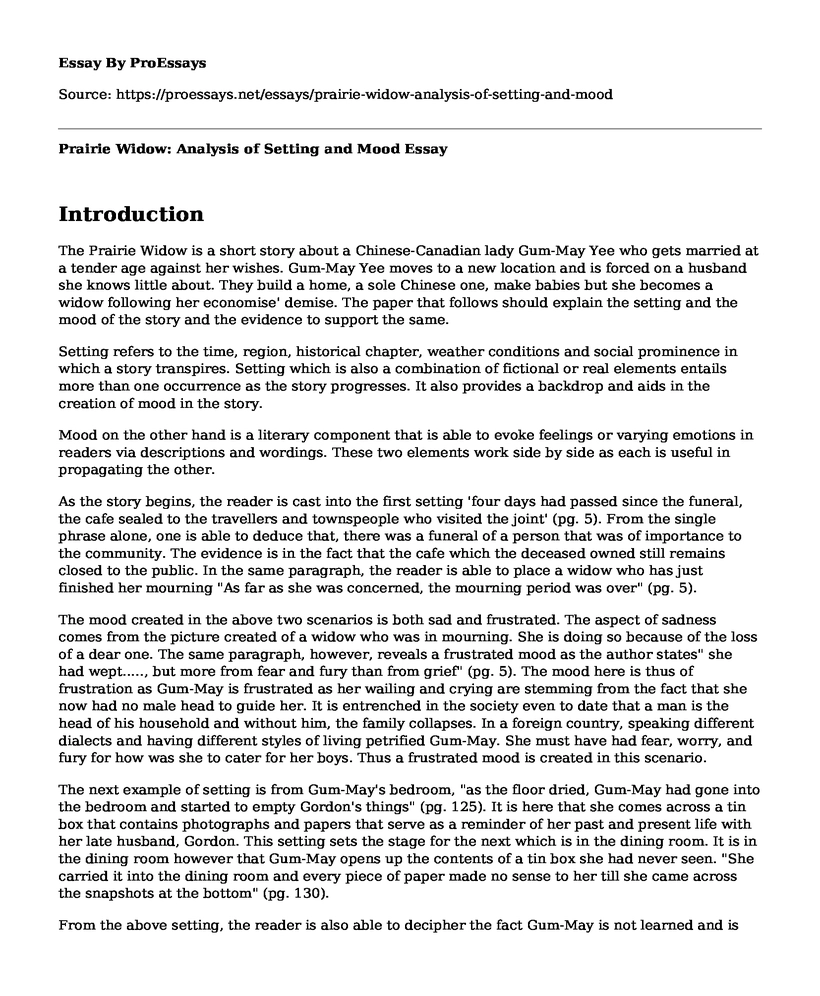Introduction
The Prairie Widow is a short story about a Chinese-Canadian lady Gum-May Yee who gets married at a tender age against her wishes. Gum-May Yee moves to a new location and is forced on a husband she knows little about. They build a home, a sole Chinese one, make babies but she becomes a widow following her economise' demise. The paper that follows should explain the setting and the mood of the story and the evidence to support the same.
Setting refers to the time, region, historical chapter, weather conditions and social prominence in which a story transpires. Setting which is also a combination of fictional or real elements entails more than one occurrence as the story progresses. It also provides a backdrop and aids in the creation of mood in the story.
Mood on the other hand is a literary component that is able to evoke feelings or varying emotions in readers via descriptions and wordings. These two elements work side by side as each is useful in propagating the other.
As the story begins, the reader is cast into the first setting 'four days had passed since the funeral, the cafe sealed to the travellers and townspeople who visited the joint' (pg. 5). From the single phrase alone, one is able to deduce that, there was a funeral of a person that was of importance to the community. The evidence is in the fact that the cafe which the deceased owned still remains closed to the public. In the same paragraph, the reader is able to place a widow who has just finished her mourning "As far as she was concerned, the mourning period was over" (pg. 5).
The mood created in the above two scenarios is both sad and frustrated. The aspect of sadness comes from the picture created of a widow who was in mourning. She is doing so because of the loss of a dear one. The same paragraph, however, reveals a frustrated mood as the author states" she had wept....., but more from fear and fury than from grief" (pg. 5). The mood here is thus of frustration as Gum-May is frustrated as her wailing and crying are stemming from the fact that she now had no male head to guide her. It is entrenched in the society even to date that a man is the head of his household and without him, the family collapses. In a foreign country, speaking different dialects and having different styles of living petrified Gum-May. She must have had fear, worry, and fury for how was she to cater for her boys. Thus a frustrated mood is created in this scenario.
The next example of setting is from Gum-May's bedroom, "as the floor dried, Gum-May had gone into the bedroom and started to empty Gordon's things" (pg. 125). It is here that she comes across a tin box that contains photographs and papers that serve as a reminder of her past and present life with her late husband, Gordon. This setting sets the stage for the next which is in the dining room. It is in the dining room however that Gum-May opens up the contents of a tin box she had never seen. "She carried it into the dining room and every piece of paper made no sense to her till she came across the snapshots at the bottom" (pg. 130).
From the above setting, the reader is also able to decipher the fact Gum-May is not learned and is not able to read or write. It is a very important setting also as it explains the naivety of Gum-May that her husband kept a tin box she knew nothing of till his death. From this setting, a melancholic mood is created which by definition is sad and pensive as she goes through old photos and papers. Through this sad atmosphere that is able to dampen one's spirits, a nostalgic mood is created (pgs. 170 -230).
The nostalgic mood is created when a character reminisces or remembers of a past that was painful and shattering. In this case, Gum-May recalls "the announcement of her marriage at only 16 years of age, an arrangement that 'demolished' her" (pg. 210). She also recalls of a stern, vicious father who "commanded her not to disappoint the family" (220) and she recalls "her first sexual encounter as very painful" (pg. 230).
Conclusion
Such is the correlation between setting and mood as clearly each element in its capacity complements the other. In so doing, a beautifully written story is spun and the different settings and moods enhance the art of language in its entirety.
Work Cited
Yee, Paul. "Prairie Widow." New: West Coast Fiction 18 (1984): 7-18.
Cite this page
Prairie Widow: Analysis of Setting and Mood. (2022, Apr 04). Retrieved from https://proessays.net/essays/prairie-widow-analysis-of-setting-and-mood
If you are the original author of this essay and no longer wish to have it published on the ProEssays website, please click below to request its removal:
- Use of Symbolism in the Poem "Daddy" by Sylvia Plath Essay
- Essay on Use of Allegory to Convey a Morality Message
- Poetry Analysis Essay on Seven of Pentacles by Marge Piercy
- Literary Analysis Essay on "After Hegemony"
- Literary Analysis Essay on Romeo and Juliet: A Reflection of Today's Evil Society
- Symbolism in Joyas Voladoras by Brian Doyle Essay Example
- Essay Example on Robert Browning's Dramatic Monologues: The Noble Quest for Precision







